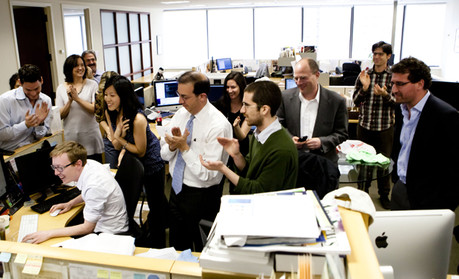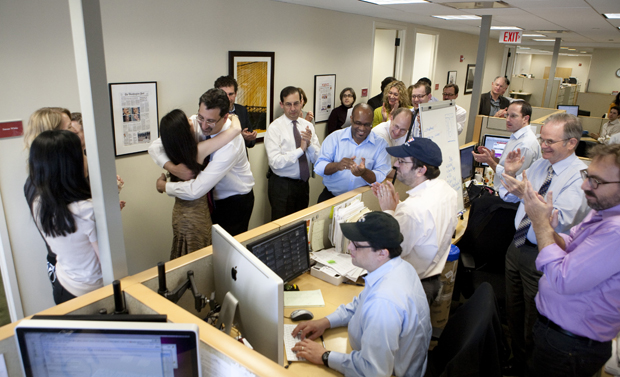
ProPublica celebrates the second Pulizer prize for one of its journalists, the first for a web-only series
Credit: ProPublicaThe digital prowess of the ProPublica newsroom was given one of the ultimate recognitions in the industry earlier this year when the US non-profit's journalists won the first ever Pulitzer prize for an online-only project, for a series on questionable practices on Wall Street.
And this was not the first Pulitzer for journalists at the investigative house which launched in 2008. Journalist Sheri Fink received the prestigious award in 2010 in recongition for work she completed with New York Times Magazine.
But given the online-only nature of the more recent prize, it marked an interesting development in the industry with the judges praising the journalists – Jesse Eisinger and Jake Bernstein – for their use of "digital tools to help explain the complex subject to lay readers".
It is therefore hard to believe that, according to editor-in-chief Paul Steiger, although data journalism is a "huge part" of the investigative journalism outlet's work, it is actually "a significant departure" from what he first imagined.
Addressing the first news summit of the Global Editors Network in Hong Kong, Steiger said the development of this area of digital journalism, alongside the growth of the organisation's web development team, went well beyond what he "originally envisaged".
And he is going to stop there. "We plan to expand it further. It has been a huge increment to what we do," he said.
Since its launch three years ago ProPublica has shared this strength in digital news, data journalism and news apps with the wider industry, working with more than 80 partners.
As part of the arrangements ProPublica shares information on the sources of stories with partners, who "can be confident it meets their standards". But if during the editing process neither side can agree on an approach moving forward, ProPublica always maintains the right "to pull it back and not give it to that partner", Steiger explained.It is possible that news organisations can have investigative reporting as part of the menu of reporting, but not to the same extent as ProPublicaPaul Steiger
"Everything we produce goes on our website. The biggest stories, those with the greatest potential, we give free to other organisations we choose as partners because we think their platforms are best for particular stories."
He said stories may be given to "very large organisations", such as its very first partner 60 Minutes, a television news programme on CBS, but also to smaller outlets such as its second partner, a "small mid-sized city newspaper".
In the latter case the story "appeared on the front page and by the middle of the day the governor turned around and changed position."
So he added, it is "not just size but positioning of a news partner that provides impact".
"Our goal is impact. We don't lobby, we use only journalistic techniques and we measure ourselves by the impact we have."
ProPublica relies on philanthropic donations to sustain its journalism. But can such a model work if there is also a goal of making money? Steiger said he did not think a "commercial version" of the US site where journalists "concentrate on doing nothing but investigative reporting" was "feasible at present".
"It is possible that news organisations can have investigative reporting as part of the menu of reporting," he said, but not to the same extent as ProPublica.
"The industry has gone from a high profit, high margin business model to one with much tighter margins and revenue," he added.
As a result news organisations are "much less able to take the risk of sending reporters out on a project that might not produce a viable story," he said.
But while the model may not be commercially viable in the US today, he said there is no reason similar non-profit outlets could not be built outside the US, saying "it just requires energy and ingenuity".
The UK has seen this first hand with the launch of the Bureau of Investigative Journalism in April 2010, two years after ProPublica.
But the cost of such operations were shown on the night of the launch of the not-for-profit, when its chair said it would need £6 million to fund its first five years of operation.

ProPublica journalist Sheri Fink celebrates her win, the Pulizer for the site. Paul Steiger is second from right
For anyone keen to take on the challenge, the secret to replicating the ProPublica model is "people, people, people", Steiger said.
"The initial notion I had was we would have journalists from a broad range of backgrounds. I could have filled a room with 40-year-old prize-winners with the nature of the business in 2008. It was just as the financial collapse was occurring and news business was going through terrible turmoil.
"I wanted a range of ages and a range of experience and the notion was we could have more experienced people to transmit skills ... so extending skill sets across the generations."
But the reverse has also taken place. "Younger people had digital DNA and they have transmitted all kinds of skill sets to more experienced colleagues."Younger people had digital DNA and they have transmitted all kinds of skill sets to more experienced colleaguesPaul Steiger
He also explained how digital was always at the heart of the vision for ProPublica.
"We knew from the beginning the website would be the core base interface ... that bigger stories would be given to larger major news platforms.
But when Scott Klein, editor of news applications, started to showcase the skills of some of the younger journalists, the site took a new direction.
Klein "began to see opportunities to exploit the skill sets of our young engineering journalists," Steiger told the conference. "And now we have a team with real firepower that makes it possible to combine traditional reporting skills with the database generation."
As for story ideas, it is usually the reporters who are at the heart of the creativity at this stage, as well as the production.
"The best ideas tend to come from reporters. What happens is we have reporters in the field looking for information. When they think they're coming across something for a story they will share it with editors who will guide them."
But that's not to say the organisation is not open to ideas from outside, which is one way partners become involved.
"The majority [of ideas] are self-generated but we have had some very major projects suggested by partners and potential partners who we have then collaborated with. I don't think we have a monopoly on all the best ideas."
Free daily newsletter
If you like our news and feature articles, you can sign up to receive our free daily (Mon-Fri) email newsletter (mobile friendly).
Related articles
- 40 essential newsletters every journalist should read
- New investigative project helps resource-poor newsrooms report on health
- New global network investigates obstacles to climate action
- Investigating human trafficking, with ICIJ lead reporter Katie McQue
- What journalists can do to prevent and fight SLAPPs









